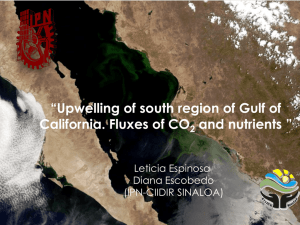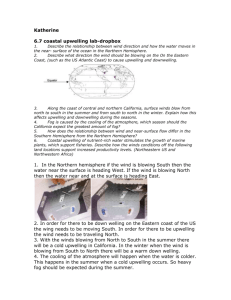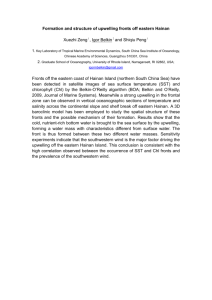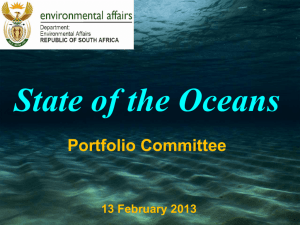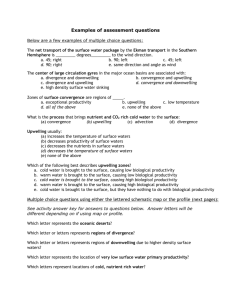"
advertisement
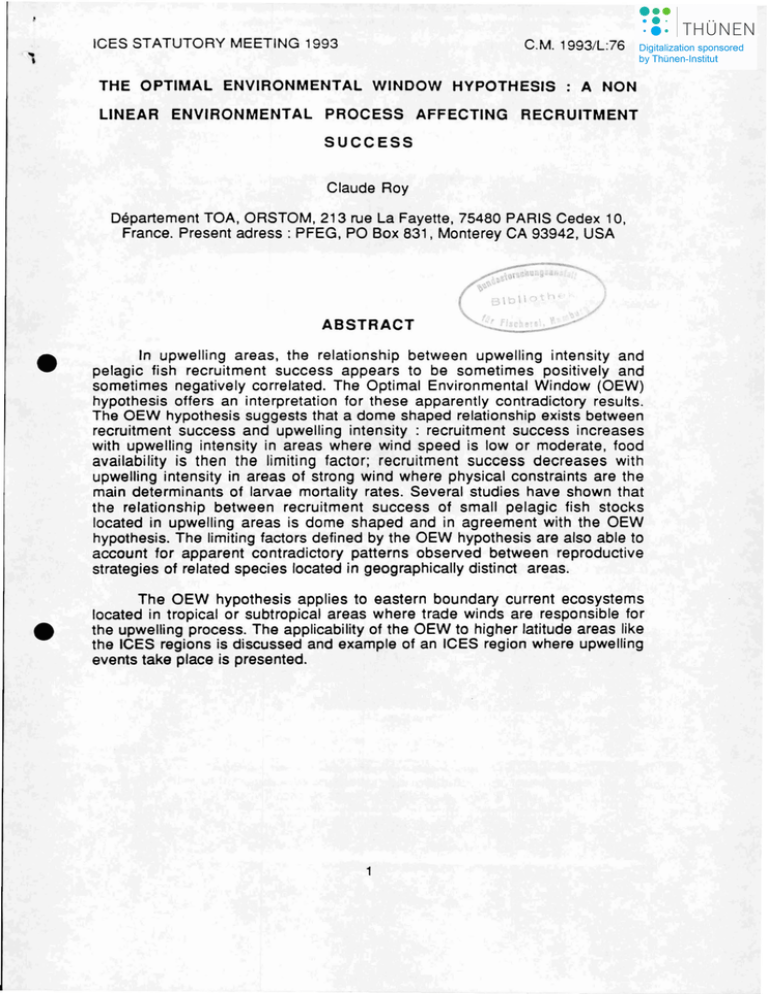
ICES STATUTORY MEETING 1993 " C.M. 1993/L:76 THE OPTIMAL ENVIRONMENTAL WINDOW HYPOTHESIS : A NON LINEAR ENVIRONMENTAL PROCESS AFFECTING RECRUITMENT SUCCESS Claude Roy Departement TOA, ORSTOM, 213 rue La Fayette, 75480 PARIS Cedex 10, France. Present adress : PFEG, PO Box 831, Monterey CA 93942, USA ABSTRACT • • In upwelling areas, the relationship between upwelling intensity and pelagic fish recruitment success appears to be sometimes positively and sometimes negatively correlated. The Optimal Environmental Window (OEW) hypothesis ofters an interpretation for these apparently contradictory results. The OEW hypothesis suggests that a dome shaped relationship exists between recruitment success and upwelling intensity : recruitment success increases with upwelling intensity in areas where wind speed is low or moderate, food availability is then the limiting factor; recruitment success decreases with upwelling intensity in areas of strong wind where physical constraints are the main determinants of larvae mortality rates. Several studies have shown that the relationship between recruitment success of small pelagic fish stocks located in upwelling areas is dome shaped and in agreement with the OEW hypothesis. The limiting factors defined by the OEW hypothesis are also able to account for apparent contradictory patterns observed between reproductive strategies of related species located in geographically distinet areas. The OEW hypothesis applies to eastern boundary current ecosystems located in tropical or subtropical areas where trade winds are responsible for the upwelling process. The applicability of the OEW to higher latitude areas like the ICES regions is discussed and example of an ICES region where upwelling events take place is presented. 1 ICES STATUTORY MEETING 1993 C.M. 1993/L:76 INTRODUCTION Many attempts have been made to correlate environmental fluctuations to recruitment indices. For the pilchard (Sardinops ocellatus), a relationship between year-class strength and sea-surface temperature is found to be positive in the southern Benguela (Shelton et al., 1985) but for the same species a negative one is found in the northern Benguela (Shannon et al., 1988). For the Iberian sardine (Sardina pilchardus), Dickson et al. (1988) found a negative correlation between catch and upwelling indices (Fig. 1). In a nearby area, Belveze and Erzini (1983) found a positive relationship between the catch of the Moroccan sardine (Sardina pilchardus) and upwelling (Fig. 1). MOROCCO SPAIN 200 r "" . """ 120 :I:~ U 0 100 <0 ...., 80 ~ ... U_ 60 ." . ~~ ~ 1.6 ~ . ~ .. '"." " 1.8 .... I c:5- • " """ .... .... Vl ~ .... •• • .... .... .... ........-.. <0 U::, . . .... ..... 100 2.0 • ......... . ". ........ • e.', • 150 2.2 • o Cl 1 0.2 Cl3 0.4 ',. ' Cl 5 UPWElLNG INDEX (ApI'il Mean) (tons' 5.1 • m l ) lP'M:WNG INDEX (Annual Me an) (ton9 5. 1. m· l ) Figure 1: An example of positive and negative correlations between catch and upwelling index obtained for the same species (Sardina pilchardusj at two different locations : the sardine off Morocco (from Belveze and Erzini, 1983) and the sardine off Spain (From Dickson et al., 1988). These results question the existence of a unified theory relating recruitment with the environment in upwelling areas. However, positive and negative correlations may both be valid if the relationship between recruitment and upwelling intensity is dome shaped as suggested by the "Optimal Environmental Window" (OEW) hypothesis (Cury and Roy, 1989). The applicability of the OEW to temperate latitude areas is discussed and the Iberian sardine is presented as an example of an ICES region where upwelling events take place. AN OPTIMAL ENVIRONMENTAL WINDOW SUCCESS IN UPWELLING AREAS. FOR RECRUITMENT Food availability and physical constraints such as wind mixing or offshore transport are considered important faetors that affect larval survival and pelagic fish recruitment. Acceptable food concentrations associated with stable ocean conditions must be present in the larvae's environment for survival (Lasker, 1981). Small-scale turbulence that increases the encounter rate between food particles and larvae (Rothschild and Osborn, 1988; MacKenzie 2 ICES STATUTORY MEETING 1993 C.M. 1993/L:76 I • and LE3ggett, 1991) mayaiso be beneficial to larval survival. Strang mixing generated by high wind speed has a negative effect on larval survival by desaggregating food and larvae patches (Saville, 1965; Peterman and Bradford, 1987) and may affect recruit~ent (Laskar, 1981). In an upwelling ecosystem, vertical advection, new inputs of nutrients and mixirig are generally closely related to the magnitude of the wind speed (Fig. 2). Increasing upwelling intensity from weak to moderate should have a positive effect on recruitment since increased primary production would enhance food availability withwind mixing remaining low. Strang upwelling should have a negative effect on rec~uitment because wind mixing is high even if primary production increases. • ",,,, 300 ...... 0 M c:> E • H' CJ Z x 200 . ~ 0 z § -- c:> :0: , X 17 • .. ~ 250 - •••• " ~ E ....... "V xw • c ~ :J X W 9 1 1.3 :::J 0.5 4 1.6 t 5 "10 • .. .- • -I a. ...." • " ~ 1 ;: 100 ...•<' • ... 1.5 ~ c• :> 0.7" ." E '. 150 .. 2 1 A . . 6 . 100 7 WIND SPEED (m/s) UPWELLING INDEX (m3ls/m) Figure 2: Relation betWeen monthly values of: or Nitrate concentration; a) upwelling Index and wind mixing b) wind speed and upwelling index or wind mixing. , . .. . Data trom 1985 to 1989 at the Cap-Vert coastal staiions (Senegal). Mear, calculatäd during the upwelling season trom January through May (See Oudot et Roy, 1991 for details).. • . The Optimal Environmental Window (OEW). hypothesis (Cury arid Roy, 1989) assumes that the relation between recruitment and upwelling indices is dome shaped (Fig. 3). The non Iinearity of Jhe curve isexplained by considering the positive or negative effects of several environmental factars. On the left side of thecurve wind is weak or moderate; an increase in the wind speed may enhance food productiön or ttis encounter. rate between larvae and food. On the right sideof the turve the upwelling is strong so thatwind-mixing and offshore transport are then detrimentalfactors. There is an "Optimal Environmental Window" for recruitment success in moderate upwellings where the effects of the Iimiting faCtors are minimized (Fig. 3). 3 ICES STATUTORY MEETING 1993 C.M. 1993/L:76 ... OPnMA L ENVIRCNMENTAL. I- Z w ! 5 a: ow a: WEAK STRCNG MODERATE WIND or UPWELUNG TROPHIC FACTORS HYDRODYNAMIC FACTORS , L1MITING FACTORS / • Figure 3 : Theoretical relationship between recruitment and environmental factars in upwelling areas (adapted tram Cury and Roy, 1989). ECOLOGICAL VALIDATIONS OF THE OEW RECRUITMENT VARIABILITY Four of the main pelagic fish stocks, all located in tropical or subtropical upwelling areas, were analyzed using an exploratory statistical method (Cury and Roy, 1989). For the Peruvian anchovy, the Californian sardine, the Moroccan sardine and the Senegalese sardinella, this comparative analysis shows that a dome shaped relation exists between recruitment and upwelling intensity (Fig. 4). The non-linearity always appears for values of wind speed around 5-6 rn/sec (Fig. 4). This suggests that for different upwelling ecosystems there is a common and "optimum" wind mixing level in the stable layers 01 the upper ocean. Using new estimates of recruitment for the Peruvian anchoveta, Mendelssohn (1989) found similar results. Using extended time series for the Pacific sardine, Ware and· Thompson (1991) supported the existence of an optimal environmental window but at a wind speed value of around 7-8 m.s· 1 . Roy et al. (1992) show new evidence of a non-linear relationship between recruitment and upwelling for the Moroccan sardine. Recently, an analysis of the Californian anchovy larvae data also supported the existence of a domeshaped relationship between larvae abundance and upwelling intensity (Cury et al., in press). 4 • ICES STATUTORY MEETING 1993 (J) ~ .. '" -, 0.2 ~ In 5 -.\ ;. . . C.M. 1993/L:76 ffi , • PERU Anchoveta (J) ~ ce: -0.6 I- • 0.2 •• 3 ~ ß ~ ~ • -0.2 ~ < ~-0.6 • ----1. • •• ~ ce: I- -0.3 ""---'------'------.. 5 .7 WIND SPEED (mls) ffi •• :J . 0.3 ~ ... ß ~ SENEGAL Sardinella • , : CALIFORNIA • Sardine (J) ~ • . .:. • • • ,I ~ \ 6 7 WIND SPEED (mls) ~ • Ci! > o ~ 0 • -0.2 LI.. 0.3 :J -0.3 ~ c:: 4. 5 6 WIND SPEED (mls) • •• •• MOROCCO Sardine CI) I- ••• -0.9 5. 7 WIND SPEED (mls) Figure 4 : Optimal transformation obtained using the ACE algorithm (Breiman and Freidman, 1985) tor the recruitment ot sardine and anchoVy in tour different upwelling areas (from Cury and Roy, 1989). , , REPRODUCTIVE STRATEGIES et • " , Using a comparative approach assuggested by Parrish ai. (1983), Roy et al.. (1989) investigated the spatial and temporal reproductive dynamies. of some coastal. pelagic fish off West Africa. The spawning areas are not continuously distributed alörig the coast and dci riöt always coincide with the location of highly productive areas.. Reproduction .occurs in places where the continental shelf broadens 01' in coastal indentations Iike a bay or downstream of a ~ap : this. str~tegy ?"ows t6 minimize th,e detrimen~aleffeCts of dispersion on larvae by reproducing where offshore transport is minimum. Similar, patterns were also found in other,upwelling ~reasJp'arrish et äl., 1983). Alo~g ~the ,West African coast, contradictory patterns emerged when the timing of spawning is examined,simultaneously with the timing of th~ upwelling~ In some areas like Senegal or lvory Coast, the spawning season coincides with the upwelling season,but iriother areas Iike Sahara and Morocco spawning and upwelling are out of phase (Fig. 5). The OEW hyp6t~esis was used to account for, these.. contradictory patterns that have emerged (Roy et al.; 1992). For the main reproductive a.rea.s off West Africa, the mean monthly wind speed is plotted versus the coastal upwelling index (Fig. 5). This allows a comparison to be made between areas of the environmental patterns during and outside the reproductive seasons. For the four different areas. spawning peaks occur at a different value of, the upwelling index (between 1 and 3.2 m3/s/m), however high reproductive activity 5 • ICES STATUTORY MEETING 1993 C.M. 1993/L:76 always Goincides with time periods of wind speed of about 6 m.s· 1 (Fig. 5). The following scheme was proposed : -in areas where wind speed during the upwelling season is close to, or lower than, the threshold value of 6 m.s· 1 , spawning occurs during the upwelling season, thus allowing larvae to benefit from the enhanced food production. -in areas where wind speed during the upwelling season is higher than the threshold value, spawning occurs outside the upwelling season or when upwelling is minimum. this strategy minimizes the negative effect of strang wind mixing on larval survival. 40 x UJ Cl Z E (!)'- ~~ m ::J UJ ~ E • I1tense spawnng o sparse or no splWnl1g 30 o ~wellra 2.0 seasal :=l • 10 WIND SPEED m/s • WIND INTENSITY Figure 5. Spawning aetivities of sardine and sardinella in relation to wind speed and upwelling for four regions off West Africa. Mean monthly upwelling indices are plotted against mean monthly wind speed for each region. The upwelling season are shaded and months with intense spawning are indicated by a black dat. Note that the black dats for all regions are clustered around 6 mls (upper figure); this value corresponds to the average wind intensity of the OEW (Iower figure). (from Roy et al., 1992). 6 ICES STATUTORY MEETING 1993 C.M. 1993/L:76 Fo"rWest .A.frican sardin(arid sardinelIas; adequate spawning locations allows to salve the detrimental e11ect of offshore transport on laNae. Such a spawning habit leaves adjustment of seasonality as an available means for dealing with ottier factors sucH as the detrimental effects of turbulence. It appears that the tuning of the spawning season is notrelated to tne seasorial occurrence of the upwelling. Rather, the spawning peaks coincide with the seasonal occurrence of wind speed of 6 m.s· 1 • This reproductive strategy appears to be the result ofa comprömise between several . antagonistic environmental factors. It have evolved in order to invest most of the reproductive effort if} the areas where and seasons when theeffects 6f the Iimiting factars for recruitment success are minimized. From an evolutionary point of view, this pattern can be interpreted as the response of ci 16ng term adaptation of reproduction to the environment for maximizing recruitment success. THE OEW IN ICES AREAS • The OEWhypothesis assumesthat both nutrient enrichment (upwelling intensity), mixing andoffshore transport are positively correlated with, the magnitude of the wind (Fig. 2). This is the case in tropical or sUbtropical Ekmantype coastal up'Nelling areas wheretrade winds are responsible forthe upwelling process.ln these regions, the positive correlation between the windmixing index" offshore .transport arid upwelling intensity is the result of the steadiness of the wind regime. The underlying assumj)tion .of the OEW hypothesis in this situation are: biological production, offshore transport and mixing are related to wind speed. In tropical 6r sUb-Üopical areas, ihe seasonallity of ttie upwelling process is induced by the latitudinal migration of tha atmospheric high pressure cells located over the oceans (Acores and Saint Helen Highs in the Atlantic); the dLiration of upwelling seasons varies from several months (California, Morocco, South-Africa, ..;)to almost year-round durations in areas Iike Cap-Blanc (WestAfrica) Baja California, oi' Peru. It is expected that seasonal and inter.annual fluctuations of the wind create corespondent fluctuations of the ecosystem biological components (Fig. 2).. • '. In temperate regions, biological productivityis highly seasorial C3:nd th,e annual, production ~ycle is dOf!linated bythe plankton spring .b,loom; ,~he . initial peak in primary production i,s attributable to the, ons"et of stratlflcation In wat~rs which ware enriched with nutrients earlier in winter by wind mixing. Primary production typically falls during summer due to a" pronounced "e~~cal stratification arid a shortage of nutriant supply., Mid-Iatitude production is distinguished from that at lower lätitudes. by .its discontinuities~, Interriperate areas,. temperature, nutrients, light, mixing and grazing are then the expected limiting factors. ,Tropical, or sUb-tropi6al .lJPwelli~g areas diffe.r from higher latitude, ecosystems. The Iimitingfactorscontrolling biological productionare not identical. In temperate areas, the Iimited duration of the growth season is in total contrast with the almost permanent processes that occur in lower hititude areas (Cushing, 1971; Wyatt, 1980). This suggests that the underlying 7 ICES STATUTORY MEETING 1993 C.M. 1993/L:76 assumption of the OEW (biological production and mixing are related to wind speed) may not always apply in temperate areas. UPWELLING IN ICES AREAS The ocean dynamics and the biology in the ICES areas may differ from the dynamics of tropical or sub-tropical upwelling areas. However, upwelling locally occurs in temperate areas : coastal trapped waves, tidal energy, eddies, wind curl are known to induce upwelling along the shel1 break (Pingree and Mardell, 1981; Bakun and Nelson, 1991; Mazeet al., 1986). Along the West coast 01 the Iberian peninsula, northerly winds generates an Ekman type upwelling in spring and summer (Wooster et al., 1976). For the Iberian sardine (Sardina pilchardus), Dickson et al. (1988) showed that there is a negative correlation between upwelling indices and catch (Fig. 1); increasing upwelling off the West coast of Portugal and Spain seems to be detrimental to sardine abundance. Arecent investigation by Cabanas et al. (in prep.) also suggests that recruitment 01 S. pilchardus between 1976-1991 is negatively correlated with the April to September mean 01 the North-South component 01 the wind stress off the West coast 01 Spain (Fig. 6). These results seems to be in agreement with the OEW hypothesis which suggests a negative correlation between wind and recruitment in areas with wind speed greater than 6 m/s. However, S. pilchardus reproduction occurs in winter or early spring in the Cantabrian Sea and juveniles later migrate to the upwelling area off the West coast of Spain and Portugal (Garcia et al., 1988; Chesney and Alonso-Noval, 1989). Recruitment variability 01 the Iberian sardine appears to be correlated with winds occuring after the spawning peak and outside 01 the spawning area (Robles et al., 1992). Therefore, the effect of wind on larvae could not be invoke to explain the observed relationship between recruitment and upweHing. 2 z 01 ~ ~ 0 ou. -1 a: Cf) : . or .- ..... - ~ -2 ~ o .• 1 2 0.3 ... 0.1 -0.1 • z ·3 ,.- 0.5 • -, .. ...... • • . \ -0.3 I' 234 RECRUITMENT (LOG) -0.5 • - 1 1 • I • , o 200 400 600 800 SPAWNING BIOMASS o -1 ·2 -'- • o I 1 I - , ·10 -20 -30 -40 PSEUDO WIND STRESS Figure 6 : Optimal transformation obtained using the ACE algorithm (Breiman and Freidman, 1985) for the recruitment of the Iberian sardine using spawning biomass (VPA analysis) and pseudo wind stress Off the West coast of the Iberian peninsula (COADS data) as dependant variables (trom Cabanas et al., in prep.). 8 • • ICES STATUTORY MEETING 1993 C.M. 1993/L:76 IDENTIFICATION OF RELEVANT RECRUITMENT SUCCESS. PROCESSES FOR Time series analysis has shown negative correlations between upwelling intensity and recruitment success of the Iberian sardine population. However, the physical and biological processes involved remain unclear (Chesney and Alonso-Noval, 1989) and it is unlikely that purely empirical approaches will clarify the involved processes. Instead, relevant environmental process for recruitment success of the Iberian sardine can be identified using the approach of Parrish et al. (1983). Since natural selection implies that reproductive strategies reflect responses to the most crucial factors regulating reproduetive success, a joint investigation of the early Iife history of the fish and of the environment is likely to reflect important causal mechanisms. This approach also provides a guide for selection of relevant variables for timeseries analysis in a way that makes improved use of the scarce degrees of freedom available (Bakun, 1986). • 10 9 +-ooof7:':'H-l i Cl w • North Coast (43-44°N 4-8°E) [Z] Atlantic Coast (42-44°N 11-goN) Spawning maximum 8 W Q. CI) Cl z 7 ~ ... 6 m/s 6 5 Feb. May Jun. Jul. Aug. MONTH Figura 7 : Monthly mean wind speed off the Atlantic coast and North coast (Cantabrian Seal of Spain.1960-1990 mean from the COADS database. • Mar. Apr. Spawning of the Iberian sardine occurs in the Cantabrian sea whyle nursery and feeding grounds are located along the coast of Galicia and off the West Coast of Spain and Portugal (Porteiro et al., 1986; Garcia et al., 1991); migration from the nursery to the feeding and the spawning grounds is observed (Porteiro et al., 1986). Intense spawning occurs during spring in the Cantabrian sea outside the upwelling area (Garcia et al., 1991). Little reproduction occurs during spring or summer in the highly produetive upwelling areas off the Spanish West coast. The spawning peak occurs in the Cantabrian Sea between April and May; simultaneously, a sharp decrease of the wind mixing is observed in this area (the value of the wind speed decrease from 8.1 m/s in March to less than 5.5 m/s in June, a value below the thereshold value of the OEW) (Fig. 7). The resulting stabilization of the surface layer appears to set conditions for a phytoplankton bloom and high larvae survival. A similar 9 ICES STATUTORY MEETING 1993 C.M. 1993/L:76 relaxatiQn occurs along the West coast of Spain but with a smaller amplitude; in that area, wind speed remains greater than 6 m/s during spring and summer. An interpretation of these patterns is that : -for the Iberian sardine, the detrimental effects of dispersion (offshore transport) are minimized by reproducing outside the upwelling area; -the timing of the reproductive season is set to take advantage of the annual spring bloom and also to avoid the detrimental effect of strong wind mixing on larvae. Year to year fluctuations of the timing of the wind relaxation may occur. Larvae survival will be particularly affected by a delay of the wind relaxation or by the occurrence of late storms which will suddenly increase mixing in the surface layers. CONCLUSION Previous studies has shown that strong upwelling is detrimental for the recruitment success of the Iberian sardine population but the environmental process involved remains unclear. An investigation of the reproductive strategies of the Iberian sardine suggests that the sardine has apparently adapted to the environment by reproducing outside the upwelling area along the coast of the Cantabrian Sea in spring and early summer; this is a region where wind speed decreases and reaches the threshold value of the OEW when spawning occurs. This suggests that a time series analysis of recruitment variability should consider the interannual fluctuations of wind off the Cantabrian coast during spring and early summer as a relevant environmental variable. Following the OEW hypothesis, a negative relationship between wind and recruitment would be expeeted. • The OEW may or may not apply to ICES areas depending on the validity of the underlaying assumptions of the OEW in the area under study. However, OEW hypothesis highlights some important characteristics on the way the environment can affeet population dynamics : -recruitment success does not always depend on a single environmental key factor but rather will be the result of the combination of different faetors aeting sometimes in opposite ways (Le. upwelling intensity and wind mixing). -non-linear relationships are to be expected between the environment and recruitment variability : upwelling can be either beneficial or detrimental, depending on its intensity. A scattergram that reveals no linear relationship does not necessarily mean the absence of a tight link and nonlinear statistical techniques are needed to explore the effect of the environment on fish population (Mendelssohn, MS; Cury et si., in press): -changes through time or between areas mayaiso occur : shift of the wind speed from one side to the other of the threshold value defined by the OEW will change the sign of the relationship between recruitment and the environment. 10 • >. , , ICES STATUTORY MEETING 1993, t C.M. 1993/L:76 '. .... ACKNOWLEDGMENT Comments by Roy Mendelssohn and Richard Parrish greatlyimproved the manuscript. This is contribution n° 27.. to the, CEOS (Climate and Eastern Ocean Systems) program, a NOAA-ORSTOM-ICLARM cooperative project supported by .the NOAA Climate and Global Change Marine Ecosystem Response project (USA) and by the TOA department of ORSTOM (France). < REFERENCES BAKUN,A. 1986. Definitiön of envirönmental vaHabiHty affecting biological processes in large marineecosystems. In: variability and management of large marine ecosystems. Ed. by K. Sherman and L.M. Alexander. AAAS selected Symposium 99:89-108. BAKUN A. AND C.S. NELSON, 1991. Wind stress curl in subtropical easterrl boundary current regions. J. Phys. Oceanogr. 21: 1815-1834. e BELVEZE, H. and K. ERZINJ. 1983. The influence of hydroclimatic factors on the availability of the sardine (Sardina pilchardus, . Walbaum) in the Moroccan Atlantic fishery. In: G.D. Sharp and J. Csjrke (Ed.) Proceedings of the expert consultation to examine changes in abundance and species composition of neritic fish resources, FAD, Fish. Rep. 291 (2): 285-327. BREIMAN; L. and J.H. FRIEDMAN. 1985. Estimating optimal transformations for multiple regression and correlation. J. Amer. Sta1. Assoe. 80: 580-619. CABANAS J.M.,Ö. PORTEIRO cind C.ROY. In prep. Influence of environmenta! fadors on sardine recruitment in the upwelling area of the Ibenan peninsula. CHESNEY,E.J. and M. ALONSO-NOVAL 1989. Coastal i.Jpwelling and the early Iife history of sardines (Sardin.ci Pilchardus) along the Galician coast of Spain. Rapp. P.-v. Reun. Cons. Explor. Mer. 191: 63-69. ~ • ., . ' ,. , CURY' P., C. ROY, R. MENDELSSOHNN, A. BAKUN, D.. HUSBY. and R. PARRISH.hi press. Moderate is better: exploring nonl.inear c1imatic effeCts on the Calofornian anchovy (Engraulis mordax). Can. J. Fish Aquät. Sei. P. CURY, and C. ROY, 1989. Optimai environmental window arid pelagic fish recruitment success in upwelling areas. Can. J. Fish. Aquat. Sei., 46 (4): 670680. . CUSHING, D. 1971. Upwelling and the produetion of fish. 9:255-334. AcJv. Mar. Bio I.. , DICKSON, R. R., KELLY P,. M., COLEBROOK J.M., WOOSTER W.S. and D. H. CUSHING. 1988. Northwinds arid production in the eastern North Atlantic. J. Plimkt. Res., 10, 1, 151-169. 11 ICES STATUTORY MEETING 1993 C.M. 1993/L:76 GARCIA A., C. FRANCO, A. SOLA, M. ALONZO and J.M. RODIRGUEZ. 1988. Distribution of sardine (Sardina pilchardus, Walb.) egg and larval abundances off the Spanish North Atlantic coast (Galician and Cantabrian areas) in April 1987. ICES CM 1988/H: 21. GARCIA A., C. FRANCO A. SOLA and A. LAGO OE LANZOS. 1991. Sardine (Sardina pilchardus, Walb.) daily egg production off the Galician, Cantabrian and Bay of Biscay waters in April-May 1990. ICES G.M. 1991/H: 37. LASKER, R. (ed.). 1981. Marine fish larvae. Morphology, ecology, and relation to fisheries. University of Washington Press. Seattle and London. 131 p. MACKENZIE B. R. and W.C. LEGGETT. 1991. Quantifying the contribution of small-scale turbulence to the encounter rates between larval fish and their zooplankton prey: effects of wind and tide. Mar. Ecol. Prog. Ser.73, 149-160. MAZE R., Y. CAMUS AND J. Y. LE TAREAU. 1986. Formation de gradients thermiques ci la surface de I'ocean au dessus d'un talus, par interaction entre les ondes et le melange du au vent. J. cons. Int. Explor. Mer., 42:221-240. MENDELSSOHN, R. 1989. Reanalysis of recruitment estimates of the Peruvian anchoveta in relationship to ether population parameters and the surrounding environment. In Pauly, 0., Muck P., Mendo J. and I. Tsukayama (eds.). 1989. The Peruvian upwelling ecosystem: dynamics and interactions. ICLARM conference Proceedings 18, 438p. Instituto dei Mar dei Peru (IMARPE), Callao, Peru: Deutsche Gesellschaft fur Technische Zusammenarbeit (GTZ), GmbH,Eschborn, Federal Republic of Germany and International Center for Living Aquatic Reseurces Management (ICLARM), Manila, Philippines. MENDELSSOHN, R. MS. If the environment affects fish in a non-linear fashion ... ? To appear in Fish. Bull. OUDOT, C. et C. ROY. 1991. Les sels nutritifs au voisinage de Dakar : cycle annuel moyen et variabilite interannuelle. In : Variabilite, instabilite et changement dans les pecheries ouest africaines, Ph. Cury et C. Roy eds. ORSTOM, Paris. PARRISH, R.H., BAKUN A., HUSBY D.M. and C.S. NELSON. 1983. Comparative climatology of selected environmental processes in relation to Eastern boundary current pelagic fish reproduction. In : Proceedings of the expert consultation to examine changes in abundance and species composition of neritic fish resources, G.D. Sharp, J.Csirke (eds), FAO Fish. Rep., 291,3,731-777. PETERMAN M.A. and M.J. BRADFORD. 1987. Wind speed and mortality rate of a marine fish, the northern anchovy (Engraulis mordax).Science , 235, 354356. 12 • \ " ICES STATUTORY MEETING 1993 C.M. 1993/L:76 PINGREE R.D. and G.T. MARDELL, 1981. Siope turbulence, internal wavas arid phytoplancton growth at the Celtic Sea shelf break. Phil Trans. Roy. Soe. lond. A302 :663-682. 'I PORTEIRO C. , F. ALVAREZ ET N. PEREZ. Hi86. Variaciones en el stock de sardina (Sardina pilehardus, Walb.)de las costas atlanticas da la Peninsula Iberica. (1976-1985). Int. Symp. Long Term Changes Mar. Fish. Pop. Vigo, 1986. 529-541. ROBlES R., C. PORTEIRO and J.M. CABANAS. 1992. The stock of AtlantoIberian sardine, possible causes of variability. ICES Mar. Sei Symp., 195: 418423. ROTHSCHllD B.J. and T.R. OSBORN.1988. The effects of turbulence on planktonic contact rates.J. Plankton Res. 10 (3): 465-474. ROY C., P. CURY et S. KIFANI, 1992. Pelagic fish recruitment success and reproductive strategy in upwelling areas : environmerital compromises. In Beriguela Trophic Functioning. Payne, A.I.L., Brink, KH., Mann, KH. and R Hilborn (Eds). S. Afr. J. mar. Sei. , 12 : 135-146. ROY C.; P. CURY, A. FONTANA et H. BELVEZE, 1989. Strategies spatiotemporelles de la reproduetion des C1upeides des zones d'upwelling d'Afrique de l'Ouest. Aquat. Living Resoure., 2:21-29. ROYj C.. CURY P., FONTANA A. et H. BELVEZE. 1989. Strategies spatiotempc5relles de la repreductien des clupeides des zenes d'upwelling d'Afrique de l'Ouest. Aquat. Living Resoure., 2:21-29. I I SAVlllE, A. 1965. Factors controlling dispersal of the pelagic stages of fish and their influence. on survival. Int. Com. for N. W. Atlantie Fisheries, Special Publicatien, 6: 335-348. I SHANNON, L.V., CRAWFORD, R.J.M, BRUNDRIT G.B. and L.G. UNDERHILL. 1988. Responses . of fish populations in the Benguela ecosystem to Emvirenmental change. J. Cons. int. Explor. Mer, 45: 5-12. • SHELTON, P.A., BOYD A.J. and M.J. ARMSTRONG. 1985. The. influerice of large scale environmental processes on neritic fish populations in the Benguela current system. CALCOFI, Rep., 26: 72-92. WARE, D.M. and RE THOMPSON. 199.1. What happened to biological produetivity in the coastal . upwelling domain in the1920s and 3ps ? Can. J. Fish. Aquat. Sei., 48:12, pp2296-2306. WOOSTER, W. 5., A. BAKUN and D.R. McLAIN. 1976. The seasonal upwellirig cycle along the eastern boundary of ttie Nerth Atlantic. J. Mar. Res., 34, 131141.. ". ..... , WY ATI, T. 1980. The growth season in the sea. J. Plankton Res. , 2,1. 13


